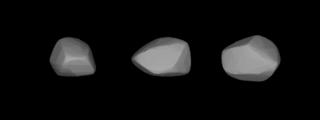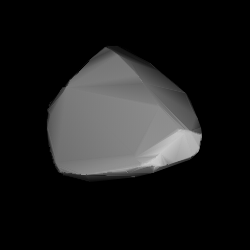
Pierretta is a 46 km main-belt asteroid discovered on 28 Aug 1891 by Auguste Charlois at Nice.

373 Melusina is a large Main belt asteroid. It is classified as a C-type asteroid and is probably composed of carbonaceous material. It was discovered by Auguste Charlois on 15 September 1893 in Nice.

380 Fiducia is a dark and large asteroid, approximately 68 kilometers in diameter, located in the central region of the asteroid belt. It was discovered by French astronomer Auguste Charlois at the Nice Observatory on 8 January 1894. The carbonaceous C-type asteroid has a rotation period of 13.7 hours. It was named "Fiducia", the Latin word for confidence.

Dodona is a large Main belt asteroid that was discovered by the French astronomer Auguste Charlois on 29 January 1894 in Nice. It is classified as an M-type asteroid.

Burdigala is a typical Main belt asteroid. It was discovered by F. Courty on 11 February 1894 in Bordeaux. It was the first of his two asteroid discoveries. The other was 387 Aquitania. Burdigala is the Latin name of the city of Bordeaux.

Ilmatar is a large Main Belt asteroid.

Siegena is a very large main-belt asteroid. It is classified as a C-type asteroid and is probably composed of primitive carbonaceous material.

388 Charybdis is a very large background asteroid, approximately 125 kilometers in diameter, that is located the outer region of the asteroid belt. It was discovered by French astronomer Auguste Charlois at the Nice Observatory on 7 March 1894. The carbonaceous C-type asteroid has a rotation period of 9.5 hours. It is probably named after Charybdis, a sea monster in Greek mythology.

Alma is an asteroid from the intermediate asteroid belt, approximately 24 kilometers in diameter. It was Guillaume Bigourdan's only asteroid discovery. He discovered it on 24 March 1894 in Paris.

394 Arduina is an asteroid from the central regions of the asteroid belt. It was discovered by A. Borrelly on 19 November 1894 in Marseilles.
Delia is a large Main belt asteroid. It was discovered by the French astronomer Auguste Charlois on 30 November 1894 in Nice. Delia is an alternate name for the ancient Greco-Roman Moon goddess. This asteroid is orbiting the Sun at a distance of 2.79 AU with an orbital eccentricity (ovalness) of 0.085 and a period of 4.64 yr. The orbital plane is tilted at an angle of 3.35° to the plane of the ecliptic.
Aeolia is a typical main belt asteroid. It was discovered by the French astronomer Auguste Charlois on 1 December 1894 from Nice, and may have been named for the ancient land of Aeolis. The asteroid is orbiting the Sun at a distance of 2.74 AU with a period of 4.54 years and an eccentricity (ovalness) of 0.16. The orbital plane is inclined at an angle of 2.5° to the plane of the ecliptic. This is the largest member of the eponymously named Aeolia asteroid family, a small group of asteroids with similar orbits that have an estimated age of less than 100 million years.
Vienna is a typical Main belt asteroid. The Tholen spectral type is S and the SMASSII spectral type is K.

Cyane is a typical Main belt asteroid.

Suevia is a typical Main belt asteroid. It is classified as a K-type/S-type asteroid.
Ingwelde is a Themistian asteroid. In light of Max Wolf's practice ca. 1905 of naming his discoveries after operatic heroines, it is most likely named after the title character of Ingwelde, an opera by Max von Schillings premiered in Karlsruhe in 1894.

662 Newtonia is a minor planet orbiting the Sun.

816 Juliana is a minor planet orbiting the Sun. It measures 59.85k in diameter. It was discovered on 8 February 1916 by Max Wolf at the Landessternwarte Heidelberg-Königstuhl Observatory in Heidelberg, Germany.

875 Nymphe is a minor planet orbiting the Sun. It is a member of the Maria family of asteroids.
935 Clivia belongs to the Flora family of Main Belt asteroids. Its diameter is about 7.9 km and it has an albedo of 0.197 .















